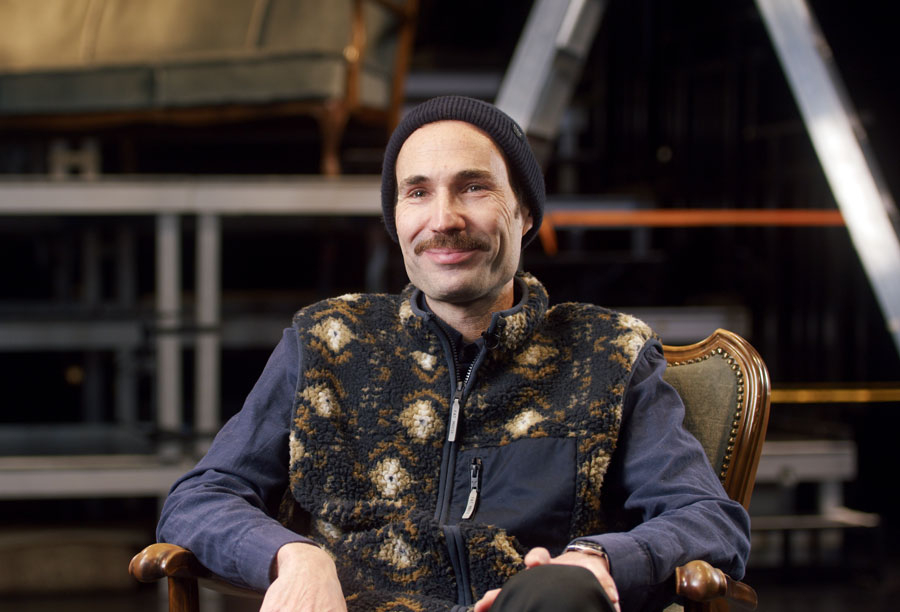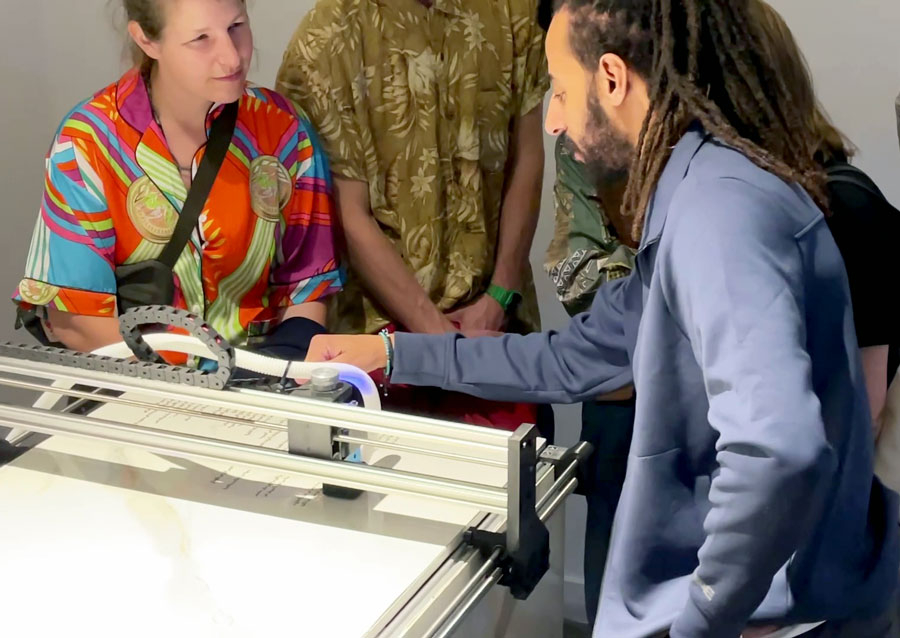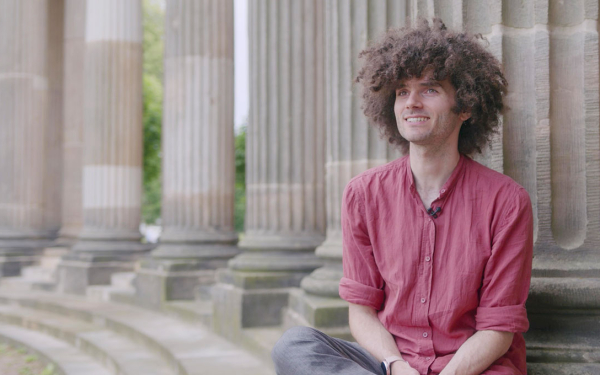
Alexandria – Yasmine Hussein
Coastal cities around the world are at risk of sinking as a result of rising sea levels in the wake of global warming. Urban researcher Hilke Marit Berger asks herself how this can be dealt with, not just technically, but above all socially and emotionally – and searches the past for answers for the future.
May 2024: from Alexandria, Hamburg-based urban researcher Dr Hilke Marit Berger posts on LinkedIn: ’This week is all about the Sinking Cities project!’ and explains: ’Together with local partners, we are researching cultural heritage and how it can be tapped as a transformative resource in processes of climate adaptation for flood-prone cities.'

ehrenwerk.tv für VolkswagenStiftung
Hilke Marit Berger in a video portrait: Learning from cultural heritage (English subtitles available)
Five months later, Berger is sitting at a table in Hamburg in the glass-walled conference room of the City Science Lab at HafenCity Universität (HCU) overlooking a canal, a side arm of the Elbe river. Mobile, large-format screens as well as pin boards covered with project information are set up in the spacious room. Visitors from all over the world come here several times a week to learn about the lab's work.
Sinking Cities
Berger opens her laptop. The 43-year-old is the Scientific Director of the City Science Lab. The 30-strong transdisciplinary team contributing to the Lab consists of experts in urban planning, architecture, sociology, computer science and philosophy, among others. In cooperation with the Media Lab of the Massachusetts Institute of Technology (MIT) and a network of international, nationwide, and local experts from science, business and NGOs, they are researching innovative solutions for growing cities – for the benefit of the population.

Hilke Marit Berger: cultural scientist, urban researcher and scientific director of the City Science Lab at the HafenCity University Hamburg (HCU).
One of the projects is the pioneering project Sinking Cities: Cultural Heritage as a Transformational Resource, which is being funded with 500,000 euros by the Volkswagen Foundation over a two-year period. The art and science project investigates how residents of the three coastal cities of Jakarta, Alexandria and Bremen are dealing with the consequences of global warming. While Jakarta is slowly sinking into the sea, water is beating against the walls of houses in Alexandria, and Bremen is experiencing increasingly severe storm surges. The aim of the project: to gain knowledge for sustainable and socially integrated climate adaptation from the intangible cultural heritage of these cities.
Berger, who has been responsible for Sinking Cities since October 2023, clicks on a link on her laptop; she has a video call with Jan-Philipp Possmann. The initial findings of her project are soon to be presented in Alexandria.
The 49-year-old dramaturge and curator is an associate researcher at Sinking Cities, along with Annika Kühn, a sociologist in Berger's City Science Lab team, and Teresa Erbach from the Research Institute for Sustainability (RIFS) in Potsdam, where the main focus is on climate change and sustainable economics.
From Baltic Sea holiday to the project idea
It was Possmann who laid the foundations for the project – or as Berger put it in the LinkedIn post from May: ‘This journey began with the incredible work of Jan-Philipp “JP” Possmann and his wealth of knowledge about sunken cities in the sea.’
In the summer of 2021, when prolonged rainfall caused the Ahr to burst its banks, first washing away roads, then destroying bridges and finally devastating houses, Possmann was on holiday on the Baltic coast of Pomerania. It was there that he first heard about the rich city of Vineta, which, according to legend, sank in a storm surge. Even though the coincidence of the actual event, the myth and the holiday by the sea was pure coincidence, Possmann was still fascinated by the new knowledge of the force that water can have: ‘Everyone knows Atlantis. But Vineta?‘ He began to do some research. ‘The sunken city is something of a universal cultural heritage: it exists everywhere and in all cultures, from the Pacific and Japan to Ukraine and the Danish coast.’

Jan-Philipp Possmann is a curator and a cultural partner within this transdisciplinary research project.
After his holiday, Possman launched his first blog: his public digital archive. On ‘Poli-Sea – Stories of belonging, loss and new beginnings. Resources for adapting to rising sea levels and sinking cities’, he linked all the films, comics, songs and stories he had collected up to that point, starting with the 1st century BC. In the meantime, Polis-Sea, a network for cultural climate adaptation, has emerged; it now includes seven scientific and cultural institutions in six coastal cities on three continents.
‘How about looking at climate change from a cultural perspective?’
Possmann's motivation? ‘I wanted to do something socially meaningful.’ Climate change is a global problem shared by everybody. However, it cannot be tackled purely by political means, as these are usually decided at a national level. ‘But what about looking at it from a cultural perspective and contributing something productive to the discussion in this way?’ This is exactly what they are currently doing in the Sinking Cities project, ‘where we are looking at current ecological problems from a historical perspective.’
Will this stop climate change? ‘No. But it could help to make the necessary adjustments to the new situation socially acceptable and sustainable for people.’ One point is particularly important to Possmann: ‘The problem with the climate discourse is that it is always discussed as an environmental problem. However, it is really a problem of care. This means that we have to ensure that everyone can cope with the changing living conditions that we have unfortunately created ourselves.‘
Transdisciplinary research into coastal cities
For their Sinking Cities project, Berger's team chose three cities from Possmann's Polis-Sea network – Jakarta, Alexandria and Bremen – that are affected to varying degrees by rising sea levels. The residents have also had different experiences in dealing with extreme weather conditions.
Jakarta, for example, one of the largest cities in the world with more than eleven million inhabitants, is sinking little by little every year – partly due to global warming. By now, 40 per cent of the urban area already lies below sea level. By 2050, the Indonesian capital will be almost completely covered by water. The sea is also gnawing away at the beach in Alexandria. In some places, it has left only a towel's length of the original 30 meters. And Bremen? It is trying to protect itself against increasingly frequent and violent storm surges by building massive dykes.
With the funding initiative ‘Pioneering Projects: Societal Transformations‘, the Volkswagen Foundation particularly supports projects that take a fresh look at existing, unexplored, or emerging societal transformation processes. To this end, the funded projects work together with partners outside the academic community; in other words: social transformation through transdisciplinarity. An approach that has become deeply embedded in the DNA of the City Science Lab Hamburg since it was founded.

In Corniche Bay in Alexandria, Egypt, the Mediterranean Sea is increasingly hitting the house facades.
‘I find transdisciplinary research extremely enriching,’ says Berger: ‘You get to know other approaches to a topic that you didn't even know existed before.’ What is needed for this? ‘Openness. And curiosity.‘ Berger has plenty of both, as her CV shows. Among other things, she studied theatre studies, was assistant director to Herbert Fritsch and, after completing her master's degree, worked as a research assistant to Prof. Dr Gesa Ziemer, who heads the Chair of Digital Urban Cultures at HafenCity University Hamburg (HCU). Berger completed her doctorate with her and then moved to the Ministry of Culture and Media as a consultant before returning to the HCU as a postdoc in 2020 – as Ziemer's deputy at the City Science Lab.
At the same time, she is currently finishing her first novel with a colleague. ‘I would really love to add the title “Expert Generalist" to my digital signature. At least that's how I see myself, and I think that's a strength. Of course, you need people who are totally focused on a topic, but you also need people who can link things together.‘
Collaborative research with equal partners
For Sinking Cities, Berger and her colleagues used their networks to find people with similarly diverse perspectives in the cultural institutions and research circles of Alexandria, Jakarta, and Bremen.

Hilke Berger and Jan-Philipp Possmann (back row, centre) with the Sinking Cities team at a project meeting in Alexandria.
‘We want truly collaborative research with equal partners.’ This is why the cultural institutions selected their artists themselves, who were supported by local researchers with a collection of material on intangible cultural heritage. Hyperlocal real-world laboratories – without any outside interference.
Does Berger already have an idea of what a possible outcome could look like, now that more than half of the project time is already over? And what is it she would really like to see? ‘No. We are still in the early stages of development. But of course, I'm very excited. The aim of collaborating with artists is to create a new approach through the artistic translation of the material.
Half-time – and the start of artistic activities
Mid-November 2024. Berger shares a post by her colleague Annika Kühn on LinkedIn: ‘After months of working remotely, we meet in Alexandria for the opening of Islam Shabana's work "Atlantis of the Marble", the first of three project exhibitions. It shows engraved memories as a testimony to life and death after the city's eventual decline.‘
During the exhibition, Egyptian multimedia artist Shabana had quotes from present-day Alexandrians laser-engraved in Arabic script onto a PVC panel with a marble look. For four weeks, the B'sarya for Arts gallery showed statements like the following by Essam Shams: ‘Alexandria is unique in its essence. My relationship with the city is my relationship with myself.‘
Only 200 people came to view Shabana's interpretation during this time – ‘the topic of global warming is too politically sensitive in a country like Egypt, where democracy and civil rights are severely restricted,’ Berger says, looking back. She was perhaps too naive. Nevertheless, she says that the work process proved to be valuable: ‘We came into contact with very different people on the ground.’

In the exhibition in Alexandria, quotes from city residents are laser-engraved on a plate.
Staring in February 2025 in Jakarta, where flooding is already an everyday occurrence, technical documents on climate adaptation will meet art. The multi-part exhibition was created in workshops organised by the artists with children and young people as well as scientists and local communities – ‘something that has never been experienced in Jakarta before’, says Possmann. There will also be an accompanying programme with readings and ‘serious games’, i. e. interactive games that impart knowledge or make complex topics tangible.
On 22 March 2025, World Water Day, the project’s Bremen partner Schwankhalle will present a world premiere of commissioned compositions about sinking accompanied by singing. This will be followed by four weeks of research by three artists together with social organisations and local researchers in Bremen's Neustadt district, the part of the city most affected by the expansion of the dykes. The works from Alexandria and Jakarta will be incorporated – and everything will be shared with the Bremen public.
‘My hope is that the variety of different approaches will show that cultural heritage really is a resource,’ says Berger. ’One that is not gathering dust in an archive somewhere, but has a vitality that can actually benefit us all. Also, in terms of mourning and letting go. Because we won't be able to save everything.’


